How To Plan A Blog Schedule That You’ll Actually Stick With
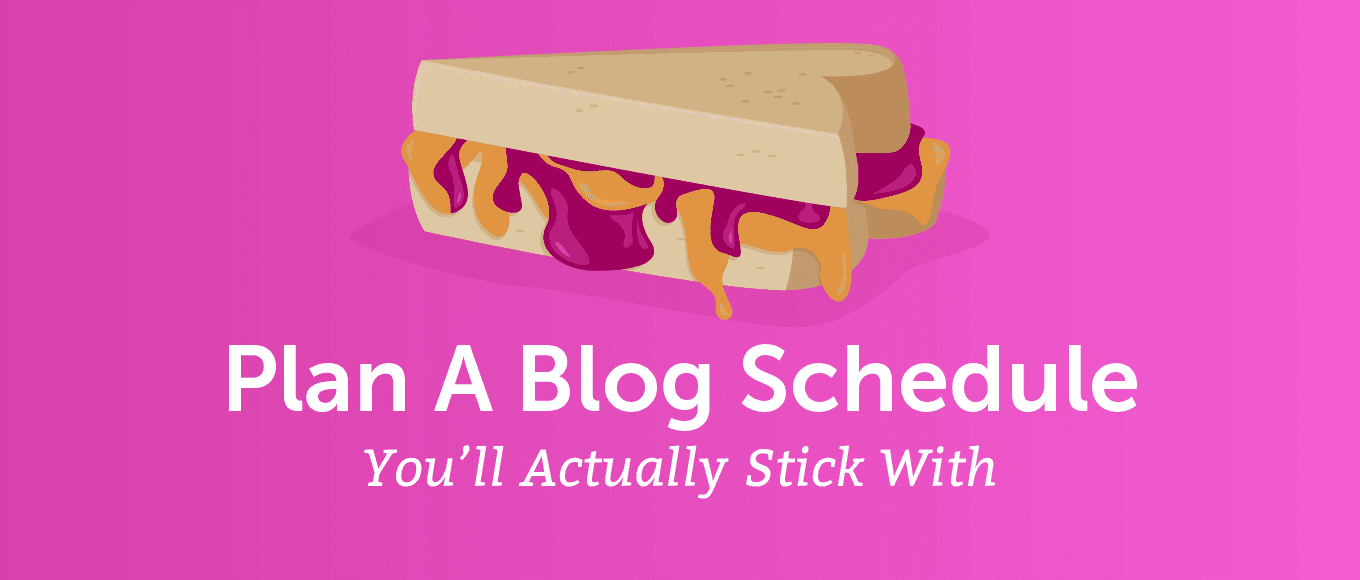 Even if you know how to write awesome blog posts, creating great content consistently can be a challenge.
It takes time and effort to produce even a single good post. That can make keeping your editorial calendar full feel impossible.
But with a well-planned blog schedule, you can make it not only possible, but easy to maintain long-term.
The key is to start small and work your way up while staying focused on your goals. And in this post, that's exactly what you'll learn how to do.
Even if you know how to write awesome blog posts, creating great content consistently can be a challenge.
It takes time and effort to produce even a single good post. That can make keeping your editorial calendar full feel impossible.
But with a well-planned blog schedule, you can make it not only possible, but easy to maintain long-term.
The key is to start small and work your way up while staying focused on your goals. And in this post, that's exactly what you'll learn how to do.
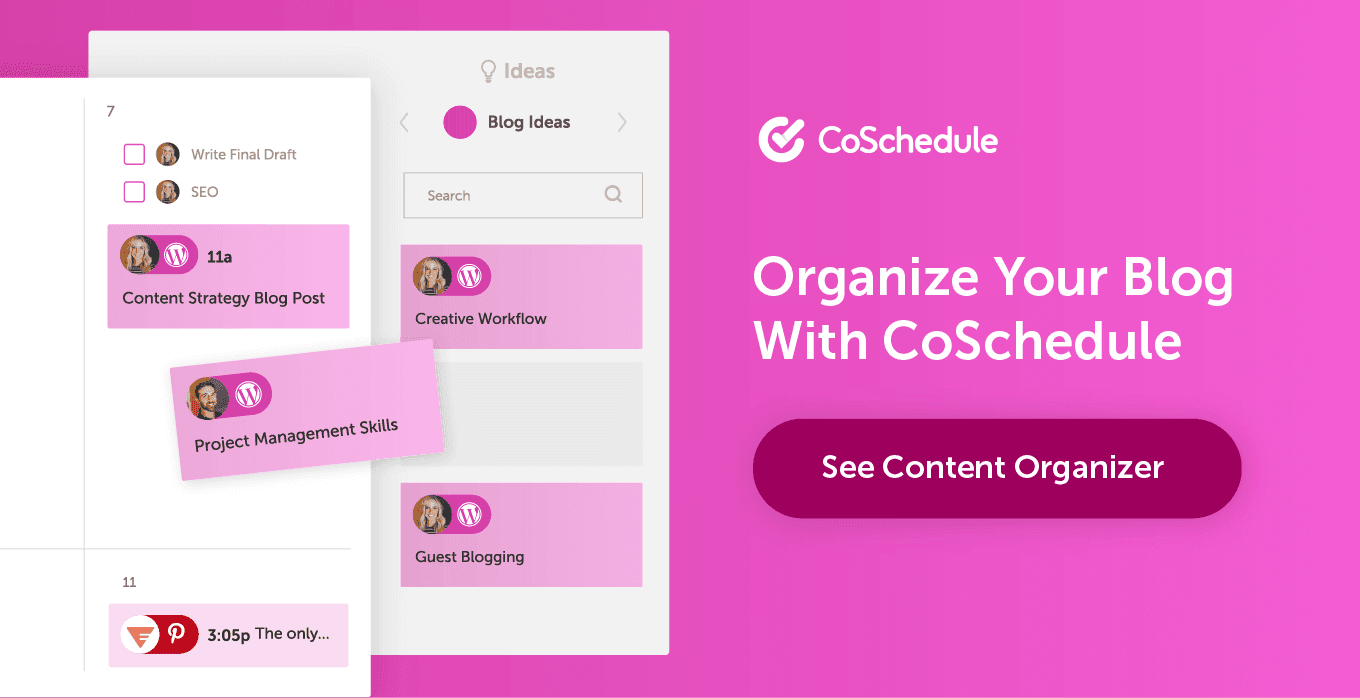
Download: Blog Schedule Template
Apply the advice in this post with these three helpful resources:- Blog Calendar Template: A simple Excel spreadsheet to map out your editorial calendar.
- Blog Schedule Template: Your guide to scaling content production for the long haul.
- Best Time to Publish Blog Posts PDF: Another guide to help dial in your publishing times.
Why Plan a Schedule for Your Blog Posts?
So you know how to write awesome blog posts. And you know how to increase your blog traffic. The next step, then, is to define a blog schedule that will help you publish those awesome blog posts super consistently to increase your:- Social media shares
- Social media subscribers
- Traffic
- Newsletter subscribers
- Customer conversions
Begin By Defining Your Blogging Goals
Chances are, you're looking to create a blog schedule because you've heard publishing consistent content can help you grow your blog. It's true! Actually, folks who publish consistent content get as much as 30% more traffic for every post they publish, all while saving about an hour per post. And not only that, it makes your life a whole lot easier to look at a calendar full of blog post ideas instead of a blank slate and wondering, "What am I going to write today?" But—defining your blog schedule or even planning to publish more content isn't your goal. Start first with a few measurements that'll help you focus your efforts on the right kinds of growth for your blog: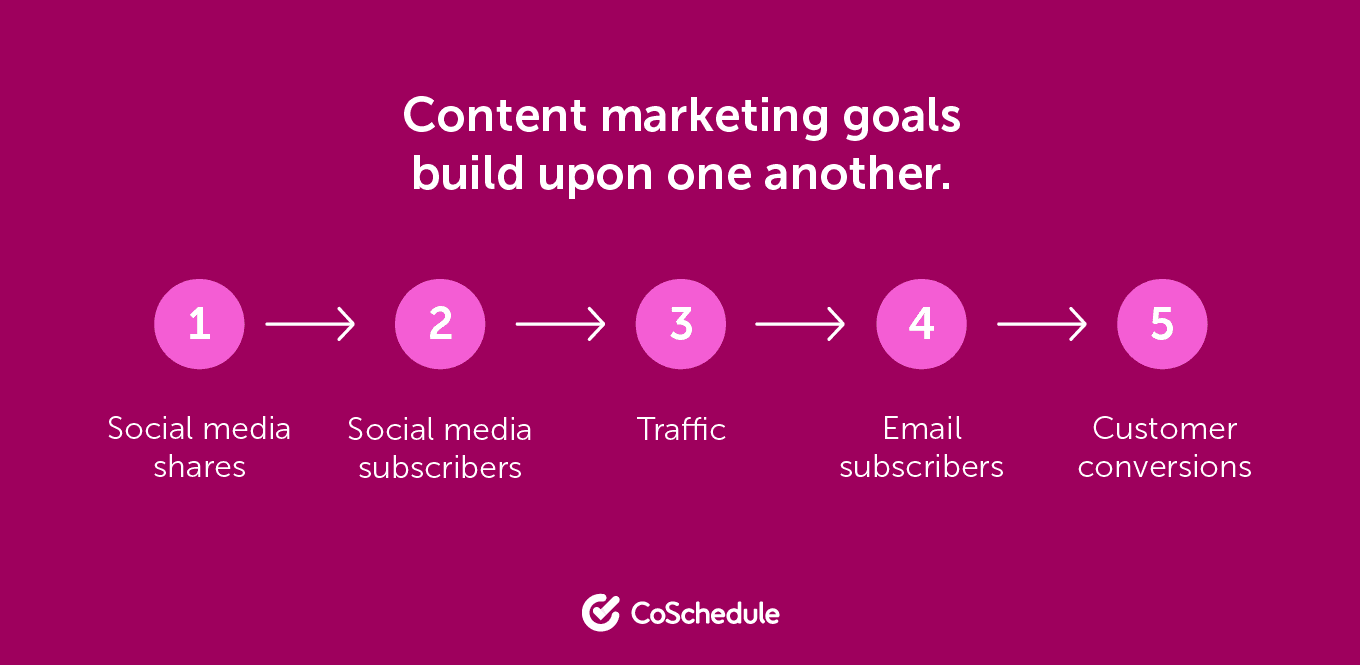 Social media shares, social media subscribers, traffic, newsletter subscribers, and customer conversions are great goals to start with. Before you even think about your optimal blog schedule, where would you like these numbers to be?
I've seen first hand how social media shares influence all of these metrics in this order to grow customer conversions. 63% of CoSchedule's blog traffic comes from social media, so you can see how all of these metrics are super important to us. These are good goals to have for your blog:
Social media shares, social media subscribers, traffic, newsletter subscribers, and customer conversions are great goals to start with. Before you even think about your optimal blog schedule, where would you like these numbers to be?
I've seen first hand how social media shares influence all of these metrics in this order to grow customer conversions. 63% of CoSchedule's blog traffic comes from social media, so you can see how all of these metrics are super important to us. These are good goals to have for your blog:
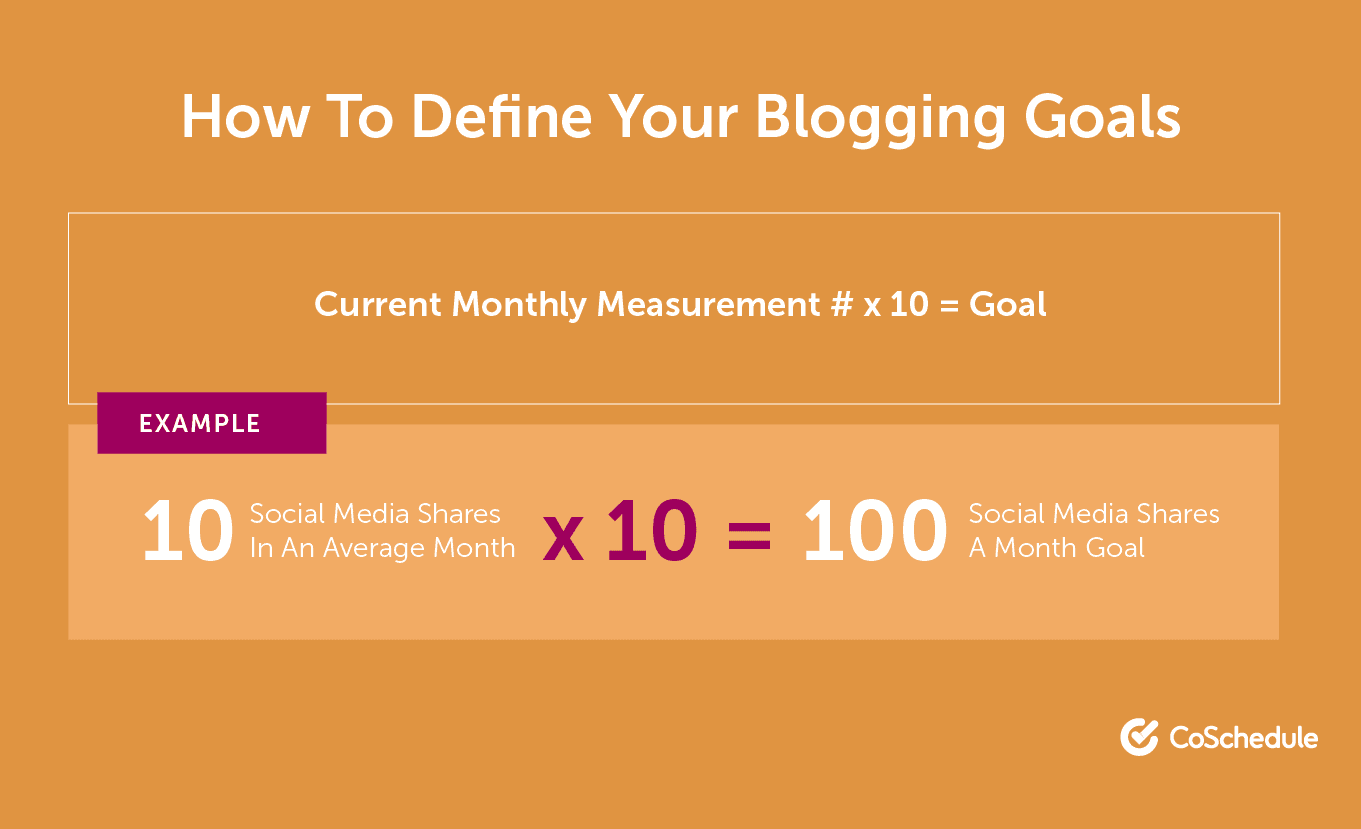 ...Essentially, think of 10x growth. This mindset is what drives every decision we make at CoSchedule on how we use our time, and it's a good model for you, too! When you add something to your plate, ask yourself, "Will this help us drive 10x growth, or is this just a nice-to-have?"
...Essentially, think of 10x growth. This mindset is what drives every decision we make at CoSchedule on how we use our time, and it's a good model for you, too! When you add something to your plate, ask yourself, "Will this help us drive 10x growth, or is this just a nice-to-have?"
- At this point, define goals for each of these metrics using the formula: social media shares, social media subscribers, traffic, newsletter subscribers, and customer conversions.
- If other measurements are more important to you, apply the formula to those to define your goals.
- It's possible that you're not looking for 10x growth for a certain goal (and maybe that is unachievable for certain measurements). Determine a figure for every goal that you will measure—just make sure there is really a number to which you will compare your results to understand how you're making an impact.
Train Your Blogging Goals to Be... Well... SMART.
Great goals are specific, measurable, actionable, realistic, and time sensitive.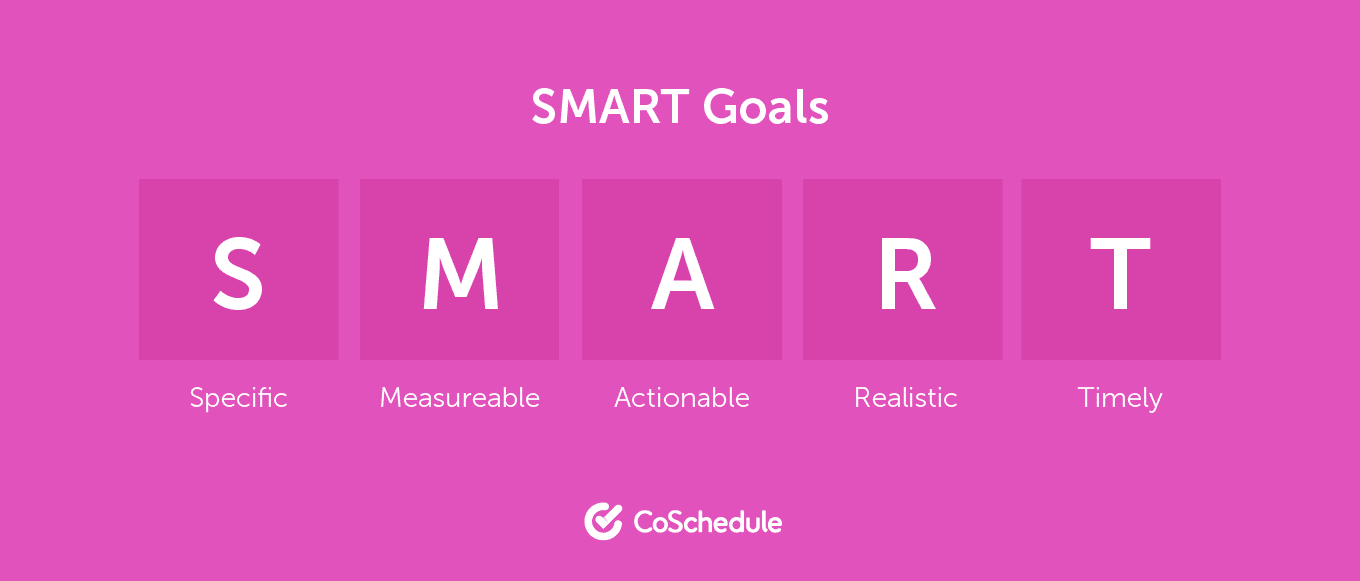 You just figured out exactly what you'll measure, so at this point, just define your goals a bit further with a format like this:
You just figured out exactly what you'll measure, so at this point, just define your goals a bit further with a format like this:
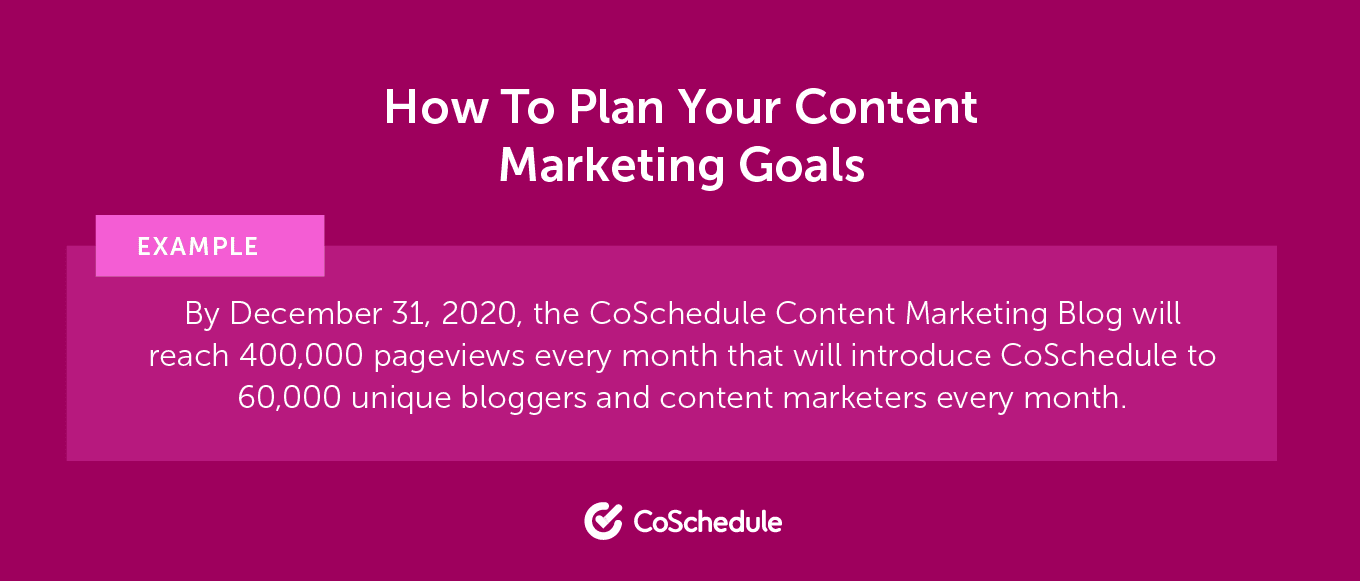 And you can do your own with a structure like this:
And you can do your own with a structure like this:
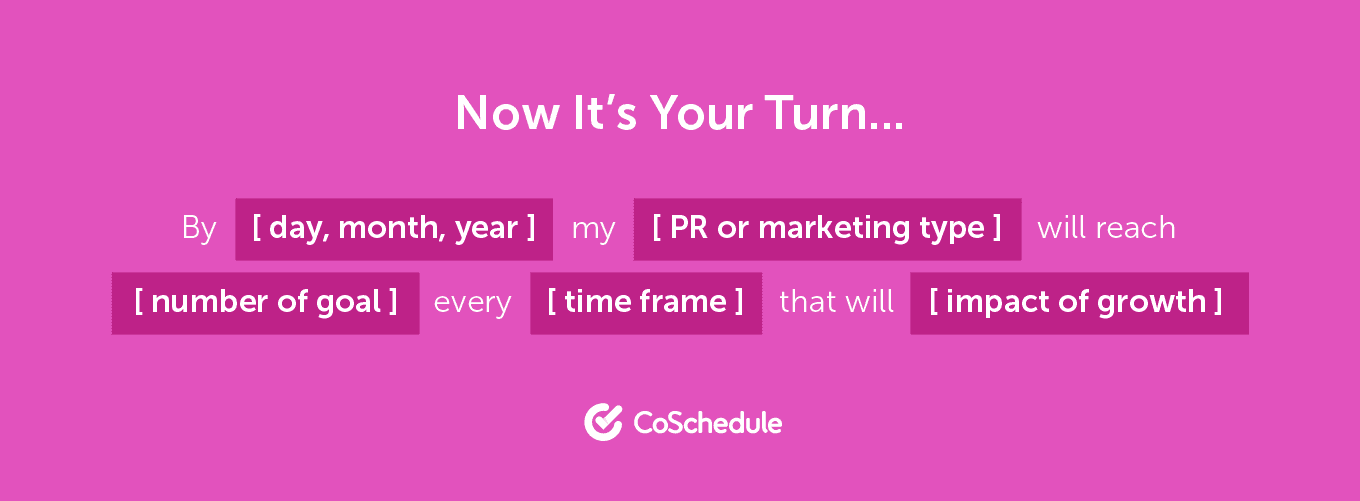
Know How You Will Really Meet Your Blog Schedule
Chances are, you want to scale your content production while producing more blog posts sustainably over time. So, before you just jump in, let's get your resources figured out to make executing your blog schedule that much easier once you get going.1. Roles You'll Need to Write Your Blog Posts:
For blogging, there are only a handful roles you need to fill:- Writing
- Designing
- Publishing
- Promoting
2. People You'll Need to Fill Your Roles:
That said, you could probably get started with as few as 3 people:- Author who writes the post.
- Designer who designs inline graphics.
- Editor who publishes and promotes the post.
You only need three people to publish awesome content. #blogging
Click To Tweet3. Tools Your Team Will Need to Complete Their Roles:
The second part of knowing your resources involves understanding what tools you'll use to create and manage your posts. For the minimum viable post that only includes text, graphics, and promotion, you may look at tools like:- WordPress for the author to write the post.
- Photoshop for the designer to design the post (or even a few free tools to design it yourself for you solo content creators out there). If you're low on budget but need a full-powered solution, GIMP is a free alternative comparable to Photoshop.
- CoSchedule for the editor to manage the entire content creation process with your author and designer, while publishing and promoting the post.
4. Time Commitment to Create Your Blog Posts:
And the last part is understanding how much time each of these things takes to do. That will help you plan backward based on the amount of effort needed for your blog posts. Here are a few things to look into for that:- Understand how long your average posts will be. That will give you some indication for a time commitment from your author (maybe multiple). For example, writing a 1,500-word post for the CoSchedule blog takes about 4–5 hours with research, ideation, and actual writing.
- Estimate how many graphics you'll include with every post. This may vary, but your designer can probably estimate how much time she needs for every post, which will help her understand her commitment to the process.
- Know exactly how you will promote your content so your editor can estimate his time commitment for social sharing, repurposing, syndication, and any other content distribution you're planning.
Find your people, tools, and time to know exactly how you'll execute your blog schedule.
Click To Tweet- Figure out the names of everyone who will help you out.
- Meet with those folks and their managers to agree on their time commitments and responsibilities.
- Know exactly what tools you need to be successful. Then get those tools in working order.
- Define a task-based workflow that will help your team complete their responsibilities on time once you get started with your blog schedule.
Plan Your Blog Schedule
Um, finally?! You could skip here, but if you don't know the goals you're trying to reach, and you have no one and no tools to help you get here, it's a little tricky to plan your blog schedule!1. Understand Your Optimal Publishing Frequency (What You'd Like To Do)
It's always helpful to understand your dream before you get started: How many posts would you like to publish every week? How about every month? That visualization is a great place to start just so you know how you'll ramp up your efforts. It's easy for the team to see how much content you'd like to publish down the road. But for now—start with a minimal posting frequency to build your momentum.2. Start Slow
I've heard of folks starting their blog and publishing tons of content right off the bat: https://twitter.com/CHontanilla/status/596412005948469248 What I fear for newbies starting that way, especially when working with a team new to blogging, is that there is tons of room for burnout by publishing too much content too quickly. Instead, in the first months especially, focus on publishing enough content to work through the awkward newness of blogging, without overwhelming your team. Give your team time after every post in your first two months to walk through what went well, what you should do differently next time, and what you should stop doing entirely. After that, you could shift those meetings to once a month. Here's what a beginner's first six months' blog schedule could look like: At this point, you've worked though a ton of content with your team, and it's a good chance to measure your results to improve your content.
At this point, you've worked though a ton of content with your team, and it's a good chance to measure your results to improve your content.
3. Measure the Success of Your First Posts You Published
You know your goals. Quickly review how an average post contributes to your goals. Now that you've worked up a consistent blog schedule, that's as easy as looking at a week's (or possibly a month's) worth of measurements for your content and averaging the numbers.Plan time to measure the success of your posts. Use that knowledge to make quick improvements.
Click To Tweet4. Calculate a Publishing Frequency to Reach Your Goals
From the previous step, you've figured out how an average post contributes to your goals to increase:- Social media shares
- Social media subscribers
- Traffic
- Newsletter subscribers
- Customer conversions

5. Is that Publishing Frequency Achievable?
When you use this algorithm, some goals may require a lot more content than others. That's fine. It's just a tool to help you gauge how much content to publish to reach your goals. And keep in mind, this is only accurate if your posts don't get more traction, which they all certainly will as you increase your publishing frequency and maintain consistency.A consistent blog schedule will help you grow your audience and get better results from every post.
Click To Tweet- How much time does it take to write, design, publish, and promote a single post?
- Is it possible for your team to scale to a happy medium amount of content publishing that either hits your goals or is really close?
- What could you quit doing to dedicate more time to creating awesome content?
- What improvements could you make in your content creation process to spend less time developing your content?
Don't sacrifice quality for quantity.
Click To Tweet6. Plan Content Improvements to Increase Success of Every Post
Chances are, you're able to publish a decent amount of content that helps you nearly hit your goals. From here, some of the best ways to reach your goals are to improve every piece of content you publish. That way, every post delivers more results to your goals, which means you can get more results by publishing less content. Considering our major goals, here are a few quick wins to increase your efficiency with each:Social media shares.
- Write social media friendly content to help people want to share your content.
- Use social media buttons in your content in the best places to help people share your content.
- Plan a social media editorial calendar to boost your shares of your content to quadruple your traffic.
Social media subscribers.
- Curate content to share with your subscribers to bring them the best of the best from your niche.
- Encourage readers to subscribe to your social accounts to get the latest and greatest from your blog.
- Include a way for readers to follow you when they sign up for emails (an easy automatic opt-in in their settings works well).
Traffic.
- Publish really useful, helpful, educational, or entertaining content worthy of sharing.
- Optimize your posts for search engines to get long-term traffic.
- Share your content on social media more than once.
Newsletter subscribers.
- Build an email list and community around your content.
- Be clear and honest with your opt-ins by telling your subscribers exactly what they'll get.
- Trade free content for email addresses.
Customer conversions.
- Map out your customers' journey from a newbie to a veteran, and write content for all stages of the marketing funnel.
- Test different email templates, subject lines, and more while including calls to action to convert.
- Ask readers to purchase what you're selling. You're providing helpful content with the goal to convert readers into buyers, so include calls to action in appropriate places throughout your content (without being overwhelmingly salesy).
7. Publish Your Optimal Blog Schedule
For example, if you decide to boost your blog schedule to publish two posts a week, here is a game plan to increase your blog schedule publishing for your next 6 months: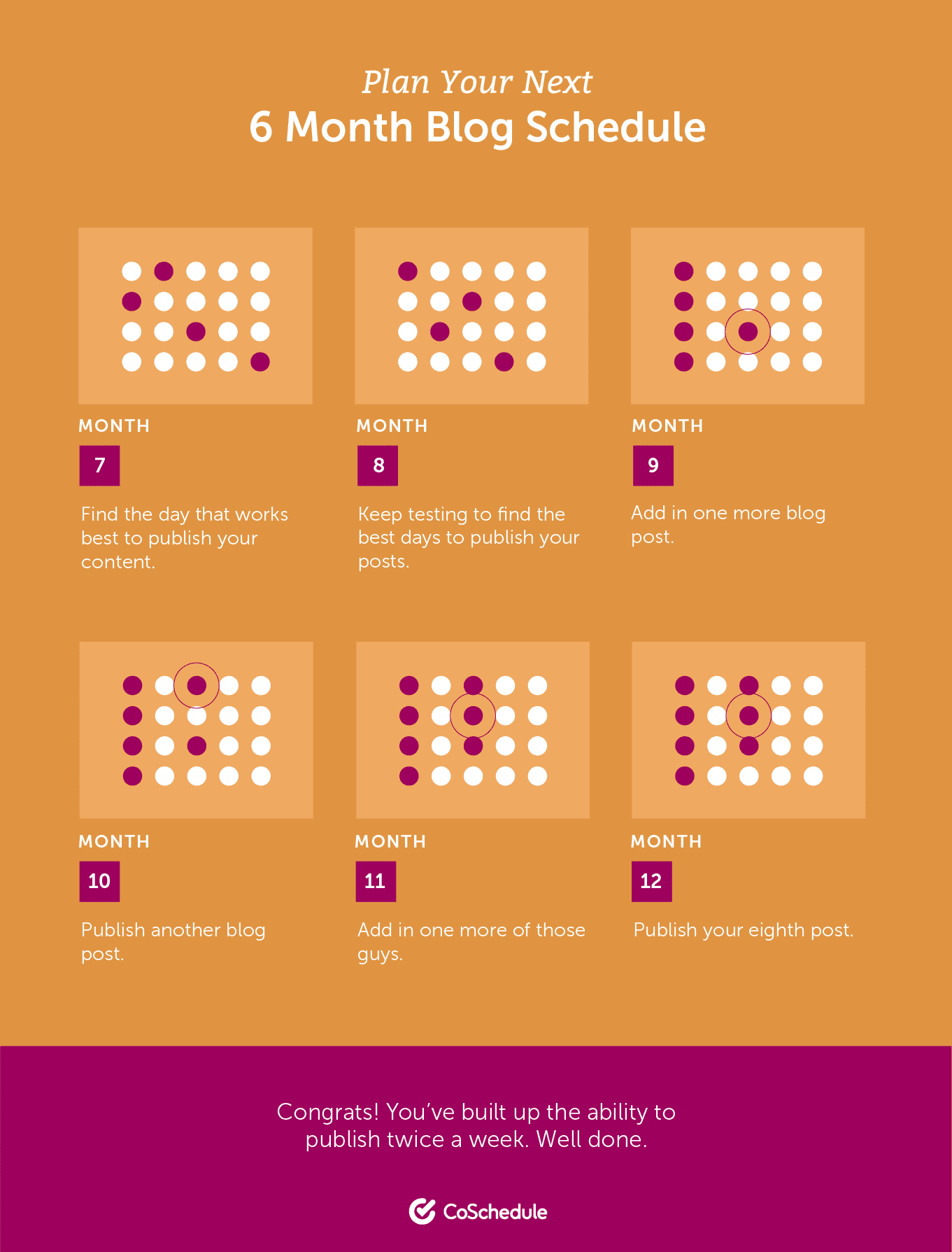 Note that the first two months involve finding the best times to publish your blog posts. That's something you'll do no matter if you're looking to publish two posts a week or more.
Use a content marketing editorial calendar template to map out your publishing frequency like this example.
Note that the first two months involve finding the best times to publish your blog posts. That's something you'll do no matter if you're looking to publish two posts a week or more.
Use a content marketing editorial calendar template to map out your publishing frequency like this example.
8. Iterate and Try New Things
This is the fun part: Execute your plan. You just planned out an entire year blog schedule for your content! Measure your goals, improve your content, and repeat, repeat, repeat. Congrats on setting up your annual blog schedule!What Is The Best Way To Plan A Blog Schedule To Crush Your Goals?
Click To Tweet

